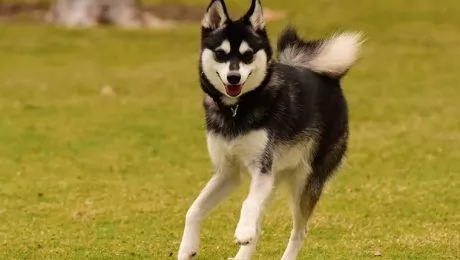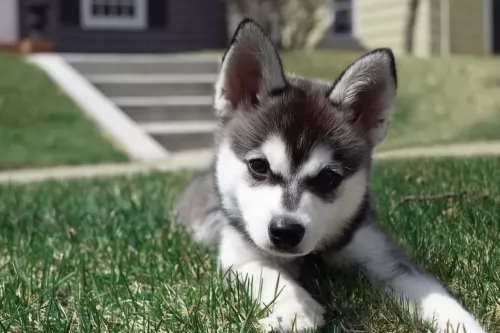 Petzlover
PetzloverAlaskan Klee Kai is originated from United States but Moscow Water Dog is originated from Russia. Alaskan Klee Kai may grow 32 cm / 12 inches shorter than Moscow Water Dog. Alaskan Klee Kai may weigh 40 kg / 88 pounds lesser than Moscow Water Dog. Alaskan Klee Kai may live 4 years more than Moscow Water Dog. Alaskan Klee Kai may have less litter size than Moscow Water Dog. Alaskan Klee Kai requires Low Maintenance. But Moscow Water Dog requires Moderate Maintenance
 Alaskan Klee Kai breed is created in Alaska by Linda S Spurlin with help of her family. When she saw a smaller type of Siberian Husky, she immediately wanted to create a smaller type of Husky that will be a great companion dog. She did not create this breed with dogs that suffer from dwarfism as if it’s the case with most other breeders. She breeds Alaskan Husky with smaller dog breeds that looked a like a husky. Breeds like Alaskan Eskimo Dog or Schipperke. They are still not recognized by some Kennel clubs, but their popularity is constantly on the rise.
Alaskan Klee Kai breed is created in Alaska by Linda S Spurlin with help of her family. When she saw a smaller type of Siberian Husky, she immediately wanted to create a smaller type of Husky that will be a great companion dog. She did not create this breed with dogs that suffer from dwarfism as if it’s the case with most other breeders. She breeds Alaskan Husky with smaller dog breeds that looked a like a husky. Breeds like Alaskan Eskimo Dog or Schipperke. They are still not recognized by some Kennel clubs, but their popularity is constantly on the rise.
The Moscow Water Dog was developed in the Soviet Union around the same time as other classic Soviet dogs. The Moscow Watchdog and the Black Russian Terrier are a couple of these other dogs. The Water Dog came from crossing the Caucasian Oytcharka with the Newfoundland. The breed is known by many names including the Vodolaz which means “diver of deep Water”. The Moscow Water Dog was only bred in the Russian state’s Red Star Kennels as working dogs for the military.
Following the second World War, most of the working dogs had been destroyed during the war. Not enough dogs could be imported to begin a breeding program for any working breed. So, the Soviet Red Star Kennels began to create several working breeds. Included in this group with the Moscow Water Dog, were the Moscow Newfoundland, the Moscow Great Dane, the Black Russian Terrier, and the Brudasty Hound.
The only really successful breed coming from this program is the Russian Black Terrier. All the rest are either extinct or found only in Russia today. The Moscow Water Dog was supposed to be a life saver/water rescue dog, but the dogs they developed were too aggressive, and the program was scrapped. It seemed that the cross had bred a dog that had too much of the working water dog traits and not enough of the rescue dog traits. The military breeders tried to pass the dogs off as a Russian Newfoundland and sell it to the non-military.
These non-military owners of the few “Russian Newfoundland”, did not try to change the dogs through breeding. Instead over time they bred the Russian Newfoundland with pure bred Newfoundlands almost eliminating the “Russian” portion of the breed. By the early 1980’s the stock had been so diluted with the pure Newfoundland that the Russian Newfoundland was basically extinct.
The Red Army kennel had other breeds with some of the genes of this breed in their lines. This included the Brudasty Hound, the Moscow Great Dane, the Caucasian Oycharka, the Moscow Watchdog and the Russian Black Terrier. The Russian Navy was unhappy with the situation and never again let the army developed the Navy’s waterdog.
 Weight of the Alaskan Klee Klei variates from dog to dog, but average male size is between 33-44cm. While females size is 28-40cm. The weight of the average male, an adult dog is 13 to 15kg. As you may see Klee Klei can be very small dogs, and that depends on every dog.
Weight of the Alaskan Klee Klei variates from dog to dog, but average male size is between 33-44cm. While females size is 28-40cm. The weight of the average male, an adult dog is 13 to 15kg. As you may see Klee Klei can be very small dogs, and that depends on every dog.
A lifespan of Klee Klei is 12-16 years.
Litter Size of the breed again depends on every dog but normal size for this breed is between 4-8 puppies.
Other Name for Alaskan Klee Klei is just a Klee Klei.
The Moscow Water Dog was intelligent, vigilant, an excellent swimmer, and great in artic waters. However, he was too aggressive and instead of saving the swimmer, they would attack them. The Moscow Water Dog is a tall, balanced and powerful dog. They have a wide muzzle and a square head like the Newfoundland. Their eyes are dark and small while the ears are triangular. The nose and lips are black. He has webbed feet of course and a hanging tail.
The coat on the Moscow Water Dog was of course waterproof and double. The top coat is very dense, straight and soft. It is usually a dark brown with some black and white.
 Klee Klei is very intelligent breed with a lot of energy. They love spending time with the family, especially in the outdoor activities. Klee Klei is very friendly towards children and new people, but they will also be excellent watchdogs too. Due to their intelligence, they are very easy to train. You should practice a positive way of awarding for them. They love pleasing and they love food, so it is a match made in heaven for training the Klee Klei. They will enjoy playing with other animals because they love to run and spend time with them, but you must socialize them from the early age. It is very important to socialize them with other animals and you will not have anything to worry about. They have a high prey drive so you will have to keep them on the leash while walking because if they notice something they will run towards it immediately. So for your, and your pet's safety, it is the best to keep the leash on. They do not bark a lot, but they will express when they are not pleasured because they can be very sensitive
Klee Klei is very intelligent breed with a lot of energy. They love spending time with the family, especially in the outdoor activities. Klee Klei is very friendly towards children and new people, but they will also be excellent watchdogs too. Due to their intelligence, they are very easy to train. You should practice a positive way of awarding for them. They love pleasing and they love food, so it is a match made in heaven for training the Klee Klei. They will enjoy playing with other animals because they love to run and spend time with them, but you must socialize them from the early age. It is very important to socialize them with other animals and you will not have anything to worry about. They have a high prey drive so you will have to keep them on the leash while walking because if they notice something they will run towards it immediately. So for your, and your pet's safety, it is the best to keep the leash on. They do not bark a lot, but they will express when they are not pleasured because they can be very sensitive
yes
Swimming and stamina
Yes but needed some land. Better in countryside.
This is an intelligent dog, but he could not be trained out of his aggressiveness.
 As most of the small breed dogs that are mixed with various breeds, this is one of the healthiest breeds. They do not have a lot of health issues, and usually, they tend to live a lot. Of course, you must be careful where are you buying your dog, and it is very important to choose the right owners that are taking care of the dogs and puppies. Some of the issues that this breed might have are luxation patella, thyroid disease, heart conditions, liver shunts, factor VII deficiency, and cataracts.
As most of the small breed dogs that are mixed with various breeds, this is one of the healthiest breeds. They do not have a lot of health issues, and usually, they tend to live a lot. Of course, you must be careful where are you buying your dog, and it is very important to choose the right owners that are taking care of the dogs and puppies. Some of the issues that this breed might have are luxation patella, thyroid disease, heart conditions, liver shunts, factor VII deficiency, and cataracts.
Because the breed was around for such a short period there is not a lot of documentation or information regarding genetic or propensity health issues. There are however a few issues that just his heritage and Newfoundland blood would lend itself to.
 Since they are highly energetic dogs they will need a lot of fuel for playing and spending time outside. Feeding of your dog depends on daily activity, but overall you should consult with dog nutritionist for a better understanding of your dog needs.
Since they are highly energetic dogs they will need a lot of fuel for playing and spending time outside. Feeding of your dog depends on daily activity, but overall you should consult with dog nutritionist for a better understanding of your dog needs.
Puppies need more food divided into 3-5 meals per day. They would eat everything you have for them. 3-5 high-quality dry food would be enough with additional vitamins and minerals.
Normally, Klee Klei groom themselves, so you won’t have to do it too often. Again, you will have to take care of your dog with occasional baths and brushing. You will know when is the time to take care of your lovely Klee Klei, but they will do most of the work.
Required high quality food made specifically for large or giant puppies. Feed 3-4 times a day a total of 21/2 -3 cups.
Required high quality food made for large or giant dog breeds. Feed twice a day a total of 2 cups.
The Moscow Water Dog did not need a high level of exercise, but they did have a lot of stamina. They loved to swim. Not overly active – more of a couch potato.